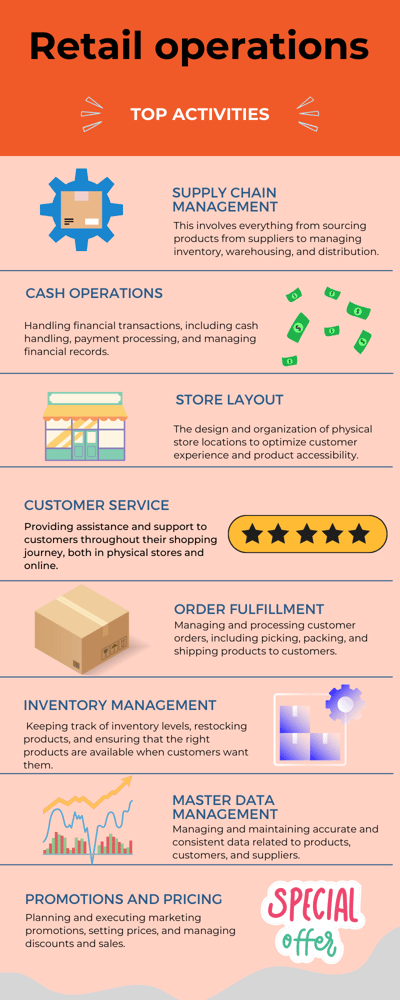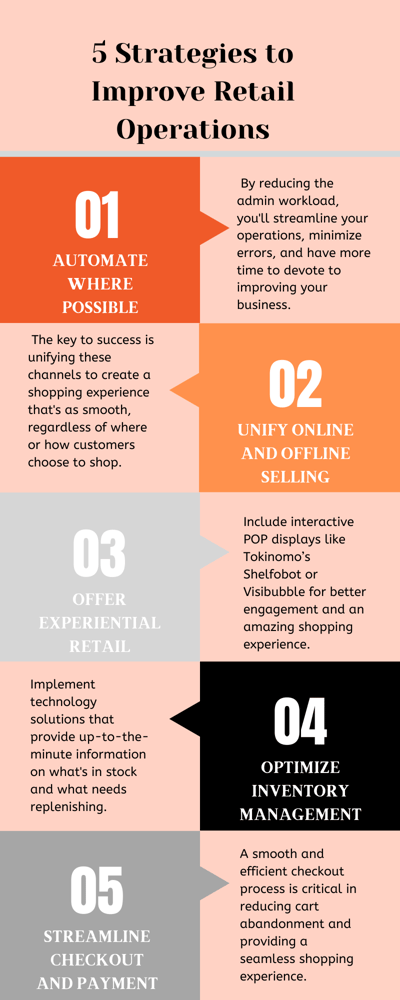In the retail world, making sure your operations run smoothly is crucial for success. This article is your guide to the best strategies for optimizing retail operations.
We'll cover the basics, challenges, and practical solutions to help your business thrive. Whether you're a seasoned retailer or just starting, these strategies will boost your efficiency and set you on the path to success. Join us as we explore the world of optimizing retail operations.
Discover:
Core Functions of Retail Operations
Best Strategies to Improve Retail Operations
The Importance of Implementing Retail Operations Strategies
What are Retail Operations?
Retail operations refer to the day-to-day activities and processes that enable a retail business to function effectively. These operations encompass a wide range of tasks and functions that are essential for the retail business to provide products or services to its customers in an organized and efficient manner.

Retail operations typically include activities such as:
- Supply Chain Management: This involves everything from sourcing products from suppliers to managing inventory, warehousing, and distribution.
- Cash Operations: Handling financial transactions, including cash handling, payment processing, and managing financial records.
- Store Layout: The design and organization of physical store locations to optimize customer experience and product accessibility.
- Customer Service: Providing assistance and support to customers throughout their shopping journey, both in physical stores and online.
- Order Fulfillment: Managing and processing customer orders, including picking, packing, and shipping products to customers.
- Inventory Management: Keeping track of inventory levels, restocking products, and ensuring that the right products are available when customers want them.
- Master Data Management: Managing and maintaining accurate and consistent data related to products, customers, and suppliers.
- Promotions and Pricing: Planning and executing marketing promotions, setting prices, and managing discounts and sales.
Core Functions of Retail Operations
Customer Service: The Heart of Retail
Customer service is where the magic happens in retail. It's not just another part of the business; it's the secret sauce that keeps the retail world spinning. Think of it as the friendly face that greets you when you walk into a physical store or the super-smooth online shopping experience that leaves you grinning.
Now, customer service isn't just about answering questions and making sales. It's about ensuring that customers have an awesome experience from start to finish. This means quick and reliable deliveries, easy returns, and support that's there when you need it.
But here's the kicker: it doesn't end when a customer clicks "buy." Nope, the post-purchase experience is where the real fun begins. This is where customers decide if they'll stick with a brand for the long haul.
Seamless Omnichannel Support
In today's retail landscape, where online and physical stores coexist, providing seamless omnichannel support is essential. This means ensuring that customers have a consistent and hassle-free shopping experience, whether they choose to shop in-store or online. From responsive customer service to integrated technology solutions, retailers must bridge the gap between different channels to meet customer expectations and maintain their loyalty.
Post-Purchase Experience Enhancement
The shopping journey doesn't conclude when a customer makes a purchase; it extends into the post-purchase experience. Enhancing this phase is crucial for building lasting relationships and encouraging repeat business. Retailers must focus on elements such as efficient order fulfillment, reliable deliveries, and hassle-free returns. By going above and beyond customer expectations in this phase, businesses can create memorable experiences that keep customers coming back for more.
Store Management: Creating Exceptional Shopping Environments
Store management is the art of crafting unforgettable shopping environments. It's not just about the physical space or the layout of an online store; it's about creating an experience that customers won't forget. Imagine walking into a physical store that's so welcoming and well-organized that you never want to leave, or browsing an online shop so beautifully designed and easy to navigate that you can't resist exploring every corner.
When we talk about store management, we're diving into two worlds: the physical store and the online store. In the physical realm, it's about making sure the store is accessible, easy to move around in, and staffed with knowledgeable and friendly team members. It's like the difference between stumbling through a maze and strolling through a well-planned garden.
And then, there's the online store. It's not just about having a website; it's about having an online space that's designed to make shopping a breeze. It's about creating a user-friendly roadmap for customers to find what they want and check out without a hitch.
Physical Store Considerations
Physical store considerations are the nuts and bolts of creating a fantastic in-person shopping experience. It's all about the real-world stuff, from the store's layout and design to the friendly faces that welcome you through the door. Think about it as the difference between wandering aimlessly in a crowded store and having a smooth, enjoyable shopping adventure.
Online Store Design and Navigation
Online store design and navigation are like the architects and tour guides of the digital shopping world. It's not just about having a website; it's about having a user-friendly online space where customers can effortlessly find what they're looking for. It's the difference between a frustrating online shopping trip and a delightful, easy-to-navigate digital journey.
Inventory Management: The Backbone of Retail Efficiency
Inventory management is like the quiet hero that ensures retail runs like a well-oiled machine. It's not flashy or attention-grabbing, but it's the backbone of retail efficiency. Think of it as the conductor of a symphony, orchestrating all the elements to produce beautiful music.
So, what does inventory management entail? It's the art of organizing and tracking all the products in a store, whether physical or digital. It's making sure you have the right products in the right quantities, at the right time. In essence, it's the unsung hero that keeps the shelves stocked and the virtual aisles brimming.
Organizing the Supply Chain
Organizing the supply chain is like conducting a perfectly timed symphony. It's the art of making sure that products flow seamlessly from manufacturers to store shelves, whether they're physical or digital. It's about predicting what customers want, ensuring products are available when needed, and preventing any hiccups in the journey from production to sale.
The Role of Inventory Management Software
Inventory management software is like having a super-smart assistant who takes care of all the nitty-gritty details. It's the technological powerhouse that tracks product quantities, predicts when to reorder, and ensures that everything is in its right place. In this part, we'll delve into the world of inventory management software and how it makes the entire inventory management process smoother and more efficient. It's the unsung hero behind the scenes, ensuring that products are where they need to be when customers want them.
Payments and Processing: Ensuring Smooth Transactions
Payments and processing may not be the stars of the retail show, but they're the stagehands ensuring everything runs smoothly behind the scenes. It's like the quiet hum in the background that keeps the retail engine running. Without efficient payment and processing systems, the show can't go on.
Point-of-Sale Systems
Think of point-of-sale (POS) systems as the conductors of the payment orchestra. They're the central hub where sales are completed, payments are processed, and transactions are recorded. POS systems not only make it easy for customers to make purchases but also help businesses keep track of sales and inventory.
Integrated Payment Methods
Integrated payment methods are like the different instruments in an orchestra, each playing its part to create a harmonious tune. In today's retail landscape, it's essential to offer a variety of payment options to meet the diverse preferences of customers. It's all about making sure that customers can choose how they want to pay and ensuring that the process is smooth and secure.
Best Strategies to Improve Retail Operations

Automate Where Possible
In the retail world, staying ahead means being smart and efficient. And one of the most effective ways to achieve this is by automating wherever possible. Think of it as having your very own retail assistant, tirelessly working in the background, handling repetitive tasks, and freeing up your time to focus on what matters most.
Reducing Admin Workload
Admin tasks can sometimes feel like a never-ending pile of paperwork. But with the right automation tools, you can conquer this mountain with ease. By reducing the admin workload, you'll streamline your operations, minimize errors, and have more time to devote to improving your business.
The Role of Inventory Management Software
Inventory management is a critical aspect of retail, and doing it manually is like navigating a maze blindfolded. Inventory management software acts as your trusted guide, providing clarity, efficiency, and precision in handling your stock. It's like having a GPS for your inventory, ensuring you never get lost in the supply chain.
Unify Online and Offline Selling
The lines between online and offline shopping have blurred. Customers expect a seamless experience, whether they're browsing your website or strolling through your physical store. The key to success is unifying these channels to create a shopping experience that's as smooth as silk, regardless of where or how customers choose to shop.
Hybrid Shopping: Bridging the Gap
Hybrid shopping, where customers switch between online and physical stores, is the new normal. To cater to this growing trend, it's essential to bridge the gap between your online and offline selling strategies.
Meeting Customer Needs: BOPIS and Beyond
Customers love the convenience of BOPIS. By providing a smooth and flexible shopping experience, you'll not only meet customer expectations but exceed them, setting your business up for success in today's hybrid shopping world.
Offer Experiential Retail
In today's competitive retail environment, it's not just about selling products – it's about creating memorable experiences for your customers. Experiential retail is all about turning shopping into an adventure, and we'll dive into the strategies that can help your business stand out.
Creating Memorable Shopping Experiences
Point-of-Purchase (POP) displays play a crucial role in experiential retail. These displays are designed to captivate customers, engage their senses, and encourage purchases. We'll explore how innovative POP displays, such as Tokinomo's interactive displays, are changing the game.
Shelfobot, Tokinomo’s first product is a POP display that can help your product become the star of the show. Thanks to light, sound, and motion technology, Shelfobot gives life to your products and helps them interact with customers in-store. Visibubble, Tokinomo’s newest addition is a small and customizable display that will help brands unify the online with the offline experience.
Building Customer-Centric Interactions: The Key to Success
Experiential retail is all about putting the customer at the center of the shopping journey. Collect and analyze data to gain insights into your customers' preferences and needs. Tailor the shopping experience based on customer data, offering personalized recommendations and communication. Ensure a consistent experience across online and physical store channels. Stay connected with customers through various channels and address their questions and concerns promptly.
Optimize Inventory Management
Efficient inventory management is the backbone of successful retail operations. Here are two essential strategies to achieve this:
Access to Real-Time Data
To make informed decisions about inventory, it's essential to have real-time data on stock levels. Implement technology solutions that provide up-to-the-minute information on what's in stock and what needs replenishing. This allows you to avoid overstocking and ensures popular items are always available to customers.
Technology Adoption for Efficiency
Embrace advanced technology to enhance your inventory management processes. RFID (radio frequency identification) tags, for instance, allow you to track and identify items more efficiently than traditional barcodes. They provide quicker inventory processing and offer better visibility into your inventory. Additionally, inventory management software can help streamline your inventory tracking, reducing the risk of errors and enabling better inventory control. These technologies improve accuracy and overall efficiency, allowing your retail business to meet customer demands effectively.
Streamline Checkout and Payment
A smooth and efficient checkout process is critical in reducing cart abandonment and providing a seamless shopping experience. Here are two strategies to streamline checkout and payment:
Reducing Cart Abandonment
Cart abandonment is a common challenge in the retail industry, with around 69% of online shopping carts left abandoned. Simplify the checkout process by minimizing the number of steps required to complete an order. Ensure that essential information, such as shipping costs and payment options, is presented upfront. This reduces friction and encourages shoppers to follow through on their purchases.
Provide Different Payment Options
Offering a variety of payment options caters to diverse customer preferences. Consider options like quick pay and buy-now-pay-later to accommodate different financial situations. In physical stores, mobile POS systems can enable staff to process payments anywhere in the store, eliminating long queues and ensuring an efficient checkout experience. By diversifying payment methods, you enhance the convenience and flexibility of the shopping experience, ultimately boosting customer satisfaction and sales.
The Importance of Implementing Retail Operations Strategies
In the world of retail, smart strategies can make all the difference. By focusing on great customer service, efficient inventory management, seamless payments, and memorable shopping experiences, you can enhance your retail operations. Implementing automation and simplifying the checkout process can also lead to happier customers and increased profits. So, whether you're a seasoned retailer or just starting out, these strategies will set you on the path to retail success.



